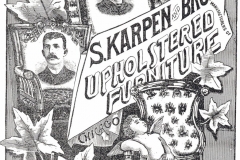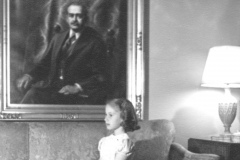S. Karpen & Bros.
A National Furniture Company
1880-1951
Tune into Antiques Roadshow and you might see an ornately carved gold leaf settee or an oversized mission leather chair. The experts would point out the metal label reading “S. Karpen & Bros.” You would think, “Karpen Brothers, I never heard of that company.” In the 21st century that is true, but from the late nineteenth century until early the 1950s, the name S. Karpen & Bros. was well known in the furniture manufacturing industry. In homes, businesses, and government offices, Americans sat on Karpen furniture, read Karpen advertisements in the magazines and newspapers, and strived to achieve the ideals of design and style the Karpen name embodied.
The Smithsonian Museum, the Chicago Art Institute, the Henry Ford Museum, and the Flagler Museum (St. Augustine, Florida) have Karpen furniture in their collections. Forbes Magazine featured the family in a 1926 article “How Nine Brothers Built Up a $10,000,000 Business,” and the Chicago Historical Society’s definitive book on the Chicago furniture industry from 1833 to 1983 highlighted the company.
Yet, no book has been written about the company or the family. We will tell the story of the company, S. Karpen & Bros.; the story of the nine brothers who came to America as poor Jewish immigrants from Prussia in 1872 and quickly became millionaires; and the story of the emergence of the unique American style.
Emily C. Rose’s Great Grandfather
I grew up looking at a large oil painting that hung over a softly curved couch in my parent’s home. The dignified gentleman Solomon Karpen was always watching me as his eyes followed me the length of our long living room.In search of my great grandfather’s story, I traveled four times from 1992 to 2003 to the town of Wongrowitz (Wagrowiec) in western Prussia (now Poland) from where the family emigrated in 1872. Jews in Prussia, unlike Jews in the other German areas in the early nineteenth century, were allowed to learn crafts. The Karpens had been cabinet makers for several generations.
Solomon’s parents Moritz and Johanna had a dream to come to America with their eight young sons; neither pogroms nor extreme poverty forced them to leave. Drawn to Chicago by the building opportunities after the Great Fire, the family worked side by side with other recent immigrants. There, their only American son was born.
By 1880, their eldest son Solomon had saved enough money to open his own furniture workshop. One by one the brothers joined the family business, and the business expanded rapidly. From the beginning, the brothers employed craftsmen who were often recent immigrants. They treated their employees like extended family with many clubs, social functions, newsletters, and financial support in times of need. They became an integral part of Chicago lore when the nine Karpen brothers formed one of the famous family baseball teams in the 1890s.
The Karpen brothers combined European design and craftsmanship and American business techniques. S. Karpen & Bros. worked with important designers, like Elsie deWolfe, Sterling MacDonald and Donald Deskey. Their public relations efforts were creative and well-planned. The business expanded across America with factories and showrooms in New York and Los Angeles.
In the 1920s, S. Karpen & Bros. branched out into the very competitive plastics industry and became “unwelcome” partners in the Bakelite Company. The diaries of the inventor of Bakelite, Dr. Leo Baekeland, relate his yet untold, hostile reaction to his Jewish partners.
S. Karpen & Bros. left its mark on the Chicago skyline. It bought and sold buildings along Michigan Avenue and even built its signature building still standing at 910 S. Michigan Avenue.
When an extremely successful business is analyzed, the usual conclusion is that it was at the right time and in the right place to take advantage of certain opportunities. As well as seizing the moment, the leaders of the enterprise also create opportunities when none were evident. Such is the case with S. Karpen & Bros. furniture company. Nine brothers built the American Dream piece by piece.
This is a family story. The immigrant father lives to see his dream only barely realized; the Jewish matriarch rules the family for decades; the family baseball team plays well-publicized games; some brothers marry Jewish women while others marry Christians; their opulent lifestyles brings troubles for the following generations; and so many more. The legitimate newspapers and the tabloids chronicled their stories.
The story of the nine Karpen brothers and S. Karpen & Bros. encompasses the decades of immigration and growth, the world wars, the Great Depression, and the emergence of modern America. While this is a family story, a Jewish story, and an immigrant story, it is also a story of the development of a part of American industry and of the change in the American family as reflected in home furnishings.
Story of Solomon Karpen as an immigrant entrepreneur. Immigrant Entrepreneurship: German-American Business Biographies, 1720 to the Present.


